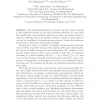Free Online Productivity Tools
i2Speak
i2Symbol
i2OCR
iTex2Img
iWeb2Print
iWeb2Shot
i2Type
iPdf2Split
iPdf2Merge
i2Bopomofo
i2Arabic
i2Style
i2Image
i2PDF
iLatex2Rtf
Sci2ools
NETCOOP
2009
Springer
2009
Springer
Optimal File Splitting for Wireless Networks with Concurrent Access
The fundamental limits on channel capacity form a barrier to the sustained growth on the use of wireless networks. To cope with this, multi-path communication solutions provide a promising means to improve reliability and boost Quality of Service (QoS) in areas that are covered by a multitude of wireless access networks. Today, little is known about how to effectively exploit this potential. Motivated by this, we consider N parallel communication networks, each of which is modeled as a processor sharing (PS) queue that handles two types of traffic: foreground and background. We consider a foreground traffic stream of files, each of which is split into N fragments according to a fixed splitting rule (α1, . . . , αN ), where αi = 1 and αi ≥ 0 is the fraction of the file that is directed to network i. Upon completion of transmission of all fragments of a file, it is re-assembled at the receiving end. The background streams use dedicated networks without being split. We study th...
Related Content
| Added | 27 May 2010 |
| Updated | 27 May 2010 |
| Type | Conference |
| Year | 2009 |
| Where | NETCOOP |
| Authors | Gerard Hoekstra, Rob van der Mei, Yoni Nazarathy, Bert Zwart |
Comments (0)

